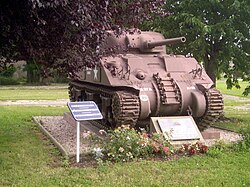Battle of Arracourt
| Battle of Arracourt | |||||||
|---|---|---|---|---|---|---|---|
| Part of the Lorraine Campaign of World War II | |||||||
 Arracourt commemorative monument |
|||||||
|
|||||||
| Belligerents | |||||||
|
|
|
||||||
| Commanders and leaders | |||||||
|
|
|
||||||
| Strength | |||||||
|
|
||||||
| Casualties and losses | |||||||
| 25 medium tanks 7 tank destroyers The 4th Armored Division's Combat Command A, which had borne the brunt of the 5th Panzer Army's counter-offensive at Arracourt, lost 25 tanks and 7 tank destroyers.[1] As a division, the 4th AD lost some 41 M4 medium tanks and 7 M5A1 light tanks during the whole month of September, with casualties of 225 killed and 648 wounded. |
200 tanks and assault guns
|
||||||
200 tanks and assault guns
The Battle of Arracourt was a major clash between U.S. and German armored forces near the town of Arracourt, Lorraine, France, between 18–29 September 1944, during World War II. As part of a counteroffensive against recent U.S. advances in France, the German 5th Panzer Army had as its objective the recapture of Lunéville and the elimination of the U.S. XII Corps bridgehead over the Moselle River at Dieulouard. With local superiority in troops and tanks, the Germans anticipated quick defeat of the defending Combat Command A (CCA) of the U.S. 4th Armored Division. However, due in part to poor German tactics and the terrain, the 4th Armored Division's CCA, in concert with U.S. tactical air forces, defeated two Panzer Brigades and elements of two Panzer divisions in a series of engagements over an eleven-day period.
For the battle, German units deployed 262 tanks and assault guns. It initially comprised two panzer corps headquarters, the 11th Panzer Division, and the 111th and 113th Panzer Brigades. The 11th Panzer Division, while battle-experienced, was badly in need of tanks, having lost most of its complement in earlier fighting; conversely, the two panzer brigades had the newest Panther tanks and fresh crews, but had virtually no battle experience, and insufficient training. The need to quickly respond to the sudden advance of the 4th Armored, as well as inadequate fuel supplies, had left the crews with shortened training schedules and little proficiency in tactical maneuvering in large-scale, combined arms operations.
...
Wikipedia
